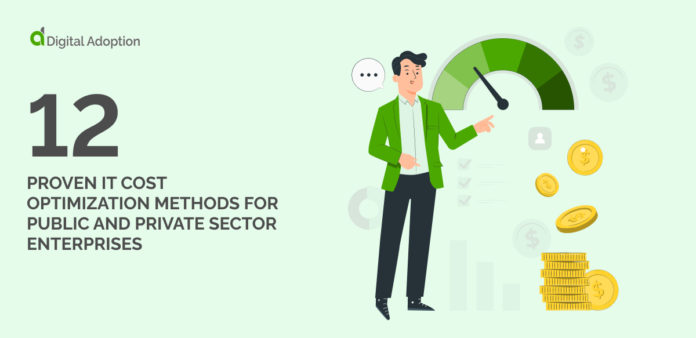IT cost optimization is a business practice that ensures a company’s IT provision is cost-effective. There are numerous ways to optimize IT costs, but the main focus is usually on reducing hardware and software expenditures.
The practice of IT cost optimization combines knowledge from different parts of an organization and is a financial exercise that requires technical expertise while also putting user interests at the forefront, thus helping to reduce barriers to digital change management implementation.
Digital adoption in business is a key concept in IT cost optimization, as the flexibility of new technologies makes it easier to find ways to reduce costs.
IT cost optimization’s outcomes might lead to vendor changes or the elimination of redundant apps. But they could equally emphasize the value of digital adoption projects for achieving efficiencies in digital resources. For example, by providing employees with the necessary training and tools to optimize their use of technology, a company can reduce its overall IT costs while improving the user experience and productivity.
This article will support anyone seeking to optimize costs in their organization. It will explain IT cost optimization before offering a complete set of ideas about how a business can get the most value out of its IT resources.
IT Cost Optimization Explained
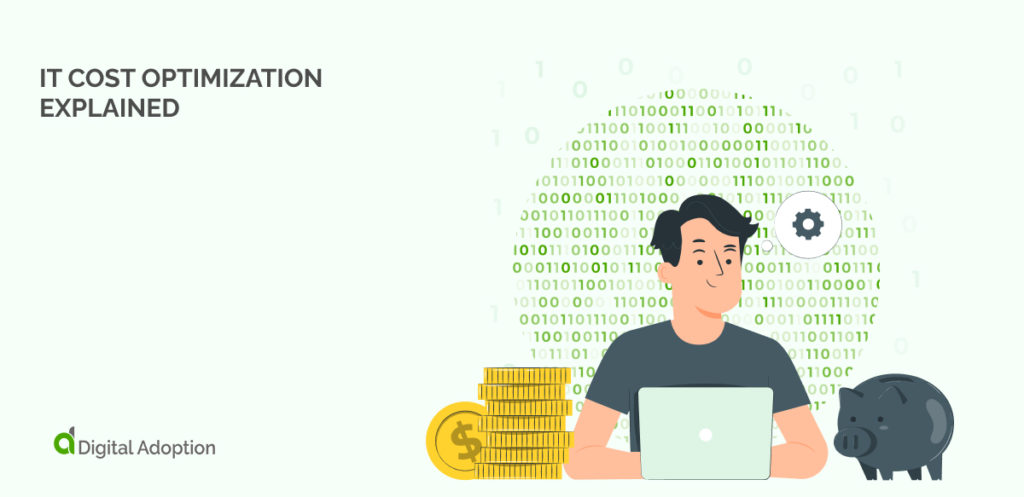
IT cost optimization is a strategic business process that seeks to drive spending and cost reduction to maximize the value obtained from business services.
IT costs can be a huge part of operating expenses. As such, strategically optimizing IT costs helps to realize long-term business goals. The process will often include the following:
- Attention to the procurement of IT services, ensuring that the company obtains the best pricing possible;
- analysis of pricing models and subscriptions;
- careful monitoring of all IT costs;
- seeking to standardize software provision arrangements, wherever appropriate;
- the removal of redundant technology and half-baked implementations;
- evaluating the ROI on IT services across different business units;
- where inefficiencies are found, advising on alternative solutions, including automation;
- finding ways to introduce new IT innovations and strategies.
The optimization process should start with implementing IT solutions for a business. It then continues for the duration of a company. Unlike cost-cutting, optimizing costs does not conclude.
Effective IT cost optimization finds ways to link the day-to-day experience with the impact of a particular strategy and connect engagement with the operational or financial outcomes that matter to any business.
Two types of cost savings: Cost-Cutting and Cost Optimization
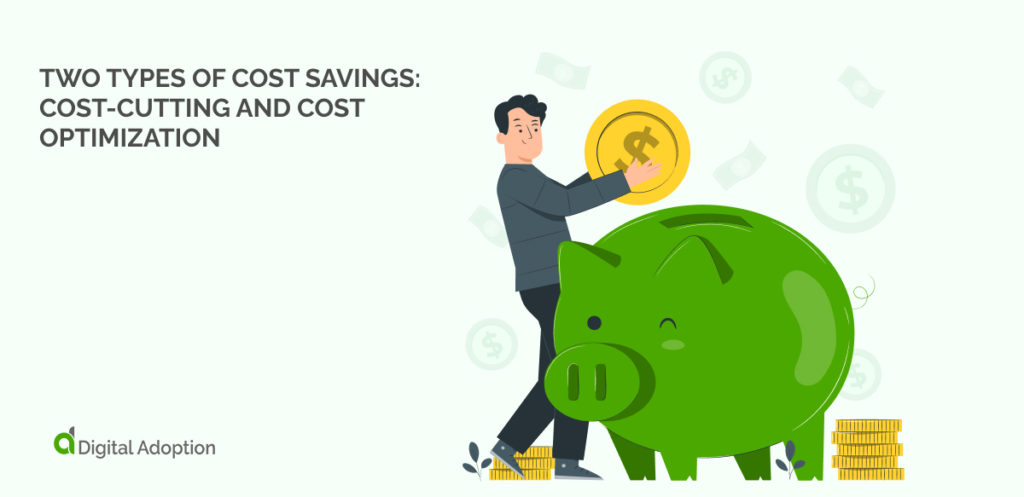
Cost-cutting and cost optimization may sometimes lead to similar outcomes, but they are fundamentally different processes.
A cost-cutting exercise is a one-time event, mainly driven by budget constraints. Cost-cutting is always unpopular, even if it is necessary. The thing is that cost-cutting can hold a company back for years. Reduced IT infrastructure will make it harder to achieve stable growth. And once IT resources are removed, company leaders will be reluctant to reinstate them later.
By contrast, cost optimization seeks the best business value. Reducing costs might turn out to be a convenient by-product. But the goal is clearly on the efficiency of essential IT resources.
Cost optimization should be conducted on an ongoing basis. A recent Gartner report showed that over 40% of managers did not achieve their optimization goals within the first year. This reminds us that managers seeking cost savings need to set out with the best possible strategies; and that they need to wait to see results.
IT Cost Optimization: Creating Inherent Value
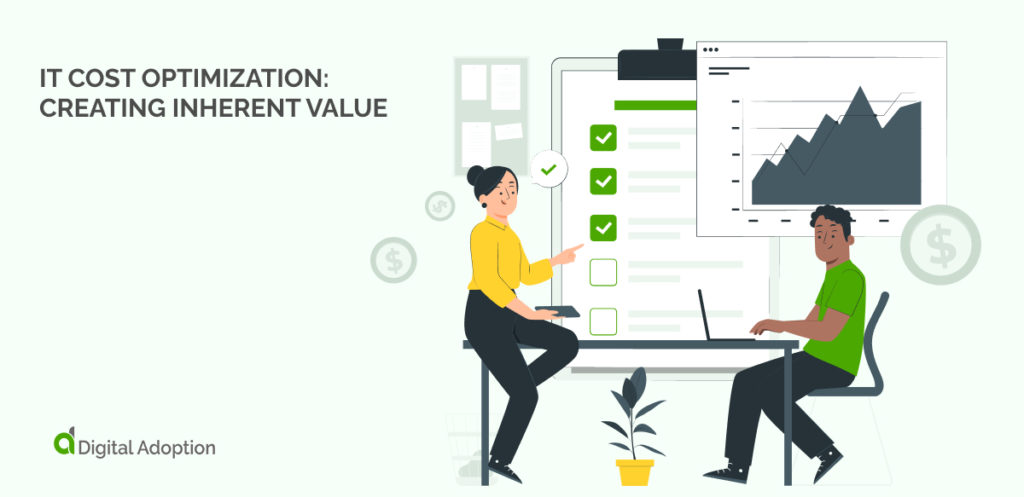
IT costs can be challenging to monitor. They can easily get out of control: and that’s why it’s so important to use optimization strategies to eliminate redundancy, excess expenses, and needless features.
It’s natural to think about reducing the cost of IT resources as efficiency. However, another way to think of the difference between cost cutting and cost optimization is through the overall value that IT resources off to a business’ services.
Cost optimization techniques lead to the creation of more value for a company’s overall operations. After all, the IT services the business provides can be improved. And with those improvements, the cost of doing business can be far cheaper.
The end product or service can be sold at a higher margin. As such, efficiency is only the short-term goal of cost optimization. Creating value for the company is the more important goal.
IT Cost Optimization Principles
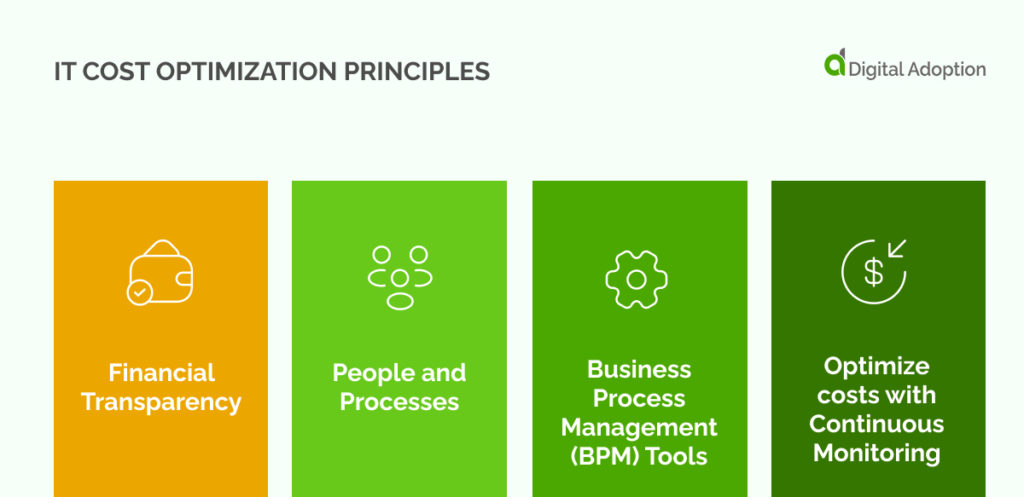
Some basic underlying principles support cost optimization. In particular, three areas should be a priority for the optimization process: transparency, the human side of the process, and finding ways to continually monitor the systems.
Financial Transparency
First, IT cost optimization and financial transparency goes hand-in-hand.
IT managers should not be defensive when IT services are threatened with budget constraints. Instead, they can use great optimization strategies to illustrate and explain their needs.
Creating complete transparency is enough to prove the business value of the money spent everywhere. If C-suite staff understand the importance that’s coming out of their IT vendor investments, the chances of maintaining a reasonable budget improve.
People and Processes
When businesses decide to go through a digital transformation of their processes, innovative technology is only part of the solution. It takes the right people to operate and connect with new technologies. In other words, IT processes don’t make sense without the staff implementing and using them.
So, people should be an essential focus of the process, too. Reducing staff numbers is an incredibly worrying decision. Implementing software that streamlines accounts, finance, or dispatch is great. But those units will struggle to adapt without well-trained staff who understand their area exceptionally well.
Good recruitment, training, and deployment practices will ensure that the new technologies in a business have the experts to go with them. IT cost optimization is a long-term strategy, not a one-off event. Like any long-term strategy, it’s essential that staff can change with the new demands of the company.
Business Process Management (BPM) Tools
Business process management (BPM) tools are another important part of IT cost optimization, as these can help businesses automate their processes and improve efficiency. Furthermore, IT cost optimization is often a strategic decision that requires buy-in from all levels of an organization, so it’s essential to involve everyone in the planning process.
BPM is a software solution that automates tasks, manages processes, and handles process logic. It is geared towards large businesses but can also be used by smaller ones. BPM systems optimize and accelerate processes, increasing efficiency. Business process automation keeps work organized and streamlined so your team can focus on more important tasks, resulting in a higher value of work.
BPM tools are being utilized more and more in today’s digital workplaces. They can help businesses streamline their processes and increase efficiency, which is a key part of IT cost optimization. Additionally, IT cost optimization often involves strategic decision-making that requires input from all levels of an organization. Therefore, it’s important to involve employees and managers throughout the planning process to ensure everyone is aligned and on board with the changes.
Optimize costs with Continuous Monitoring
Monitoring is at the heart of any ongoing cost optimization project.
In some respects, cost monitoring is highly technical. It will take a specialist to understand what parts of the system need monitoring and the overall price of services. Fortunately, extensive cloud services now provide cost dashboards to monitor and control spending.
But even with the most efficient structures in place, monitoring is a matter of people management. Monitoring requires that people use packages effectively – for example, using the appropriate tags in Azure.
Continuous monitoring has a prominent link to the principle of financial transparency. When every user knows the cost of the services they are using, they will be better placed to consider the best way to achieve a good ROI.
12 IT Cost Optimization Techniques
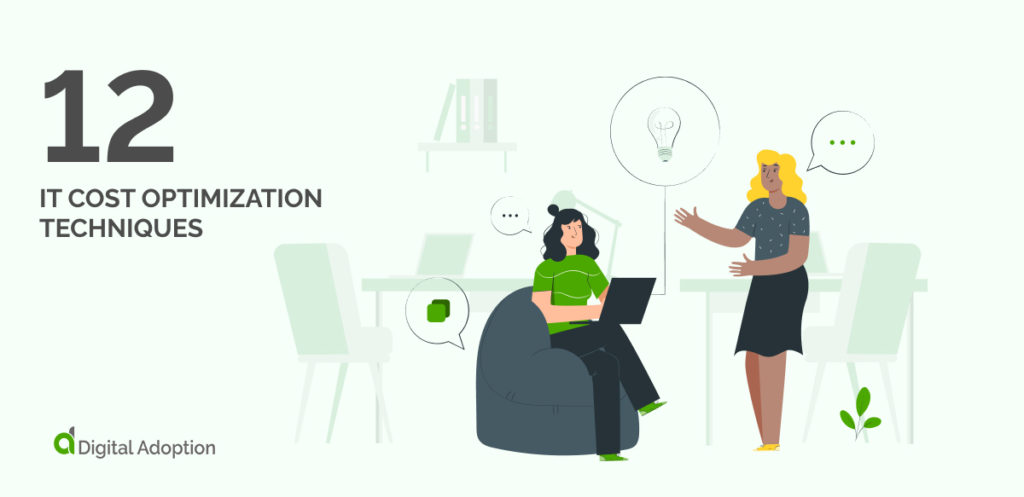
Once a company understands the basic cost efficiency principles, it can apply specific cost optimization strategies. The following twelve ideas will help with any cost optimization initiative.
- Rationalize Enterprise Technology Portfolio
A good initiative can start with a transparent audit of all the technology that the company currently uses. It can be as simple as a spreadsheet listing all the applications used within the organization, detailing the features, costs, and intended users.
An essential application for one business unit may be completely unheard of elsewhere. As such, keeping a clear eye on all the subscription-based applications within an origination can be difficult. Rationalization means that you know what’s going on and where.
- Leverage Shared IT Services
Once an organization knows its IT resources, it can decide how to share its subscriptions more effectively.
When services are used across different business units, a business can make sure that they are pursuing a shared procurement and subscription package. This can lead to surprising cost savings through more competitive pricing models.
- Opt For Cloud Services
Cloud resources are now one of the dominant ways of bringing technology into a company. It would be challenging for some applications to mobilize a genuine site-based option.
Cloud-based software is itself a great cost optimization technology.
Cloud-based software can often be more flexible than existing systems, making it easier to adapt the service over time. With that functionality, cloud transformation can more rapidly lead to business innovation.
- Integrate and Modernize Data Centers
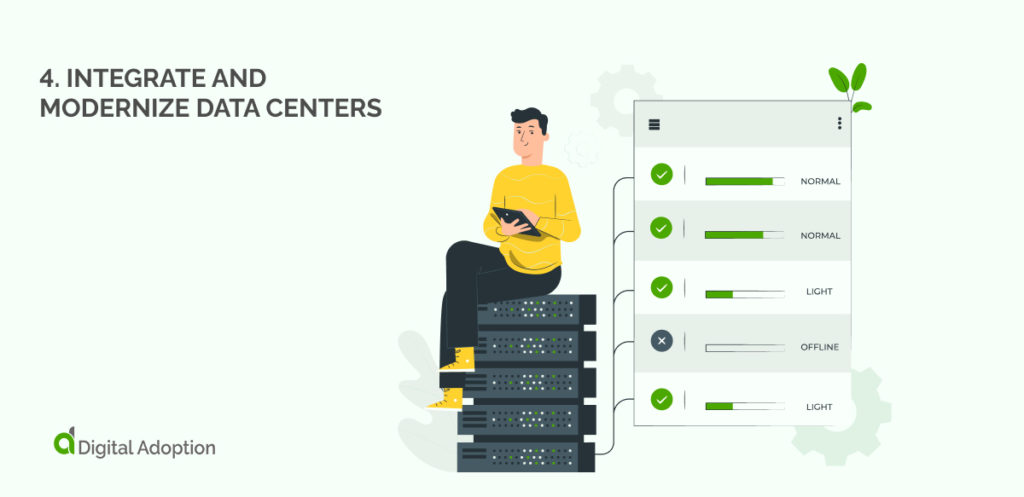
A data center is one of the most vital parts of IT infrastructure, even though many users will never think about it. A report from McKinsey suggests that better data management can reduce costs without negatively impacting business processes: “for example, by offloading historical data to lower-cost storage, increasing server utilization, or halting renewals of server contracts.”
As data needs grow with a company, so will its storage needs. Bringing every storage provision into one data center will inevitably reduce costs and maintain the simplicity of operations.
- Re-evaluate IT Asset Management and Operating Costs
IT asset management monitors all aspects of IT infrastructure. It provides a detailed understanding of the specific items held by a company. That will include detailed information on servers, printers, and computers; the software running on particular machines; and networked devices.
On a day-to-day basis, good asset management helps to support customers. For cost-saving purposes, it can help set a budget for future years. If the organization’s hardware is entirely up-to-date, they know they can avoid upgrade costs in the next few years.
But if some terminals require an upgrade, asset management software can quickly identify the scale of investment costs.
- Improve IT Budget Transparency [JH adapted]
Managers can achieve cost savings simply by understanding full information about their current spending on IT. A full overview of the company’s IT spending means that excess spending can be easily identified and quickly cut back.
- Increase IT Demand-side Spending
Businesses may lead some IT resources with supply-side spending. In other words, if a particular package is offered to staff, they can use it.
However, demand-side spending can lead to far more efficient deployments of technology. More demand-side spending means new apps and functions are offered when required.
- Exploit Robotic Process Automation and Artificial Intelligence
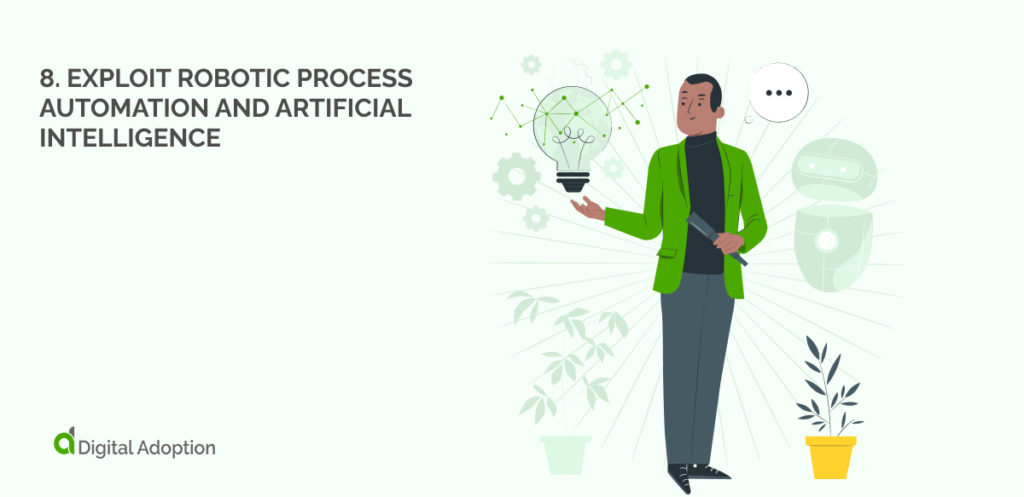
There’s now a wide choice of software available to help automate simple tasks in an organization. Those include the routine aspects of accounting, payroll, and workload management and even extend to parts of training and e-commerce. Automated processes are efficient and reliable, often offering an excellent ROI and overall cost savings.
- Evaluate Digital Business Transformation Ideas
Companies that want to go further with process automation and AI can start to consider a full-scale digital implementation strategy.
A large-scale digital adoption policy can lead to major savings in how a company works. Digital transformation is a business-wide transformation project that uses digitalization to achieve business growth.
Applying digital solutions to business processes can lead to highly effective savings in the long term.
- Optimize Workforce Management (WFM)
WFM covers many areas of business operations, including forecasting, scheduling, timesheets, payroll, compliance, and more. While it is not only about IT, WFM is almost totally automated now. A well-running set of WFM software will lead to savings in all other parts of the business.
- Improve Data Transparency
Shared knowledge of data holdings can improve many organizational working practices. When staff can identify information about data, they will find it easier to build collaborations between business units instead of re-collecting data in any form.
- Organizational Discipline and Digital Adoption Training
Finally, it’s worth remembering that staff are at the heart of good IT cost optimization work. Cost savings should not make their job more complex or confusing. Excellent training ensures that the company’s application portfolio is used effectively by staff. Good digital adoption ensures that companies optimize existing assets’ value using new methods.
How To Build A Fool-Proof IT Cost Optimization Strategy
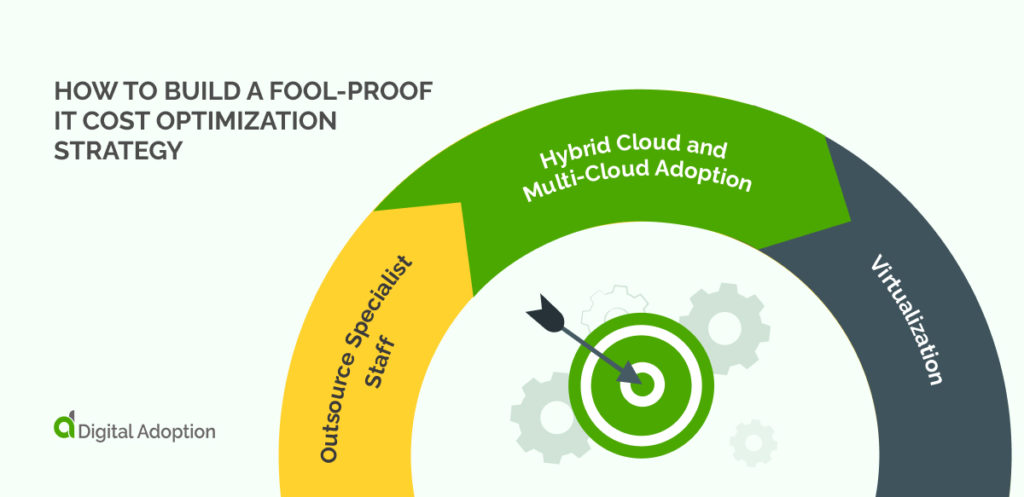
On top of the strategies described above, three major areas can help to make cost optimization effective.
Outsource Specialist Staff
Getting the most out of internal IT resources may involve long-term employees. However, for more specialist work, outsourcing can be highly cost-effective. Outsourcing helps bring specialist knowledge into a company, even without a permanent workload.
Hybrid Cloud and Multi-Cloud Adoption
With this strategy, a company’s IT infrastructure comprises private and public cloud services alongside on-site storage. Cloud solutions make it far easier for a company to pay for the IT resources they need without a bloated application portfolio that doesn’t fit their needs. A hybrid system enables a company to use the best cloud systems for whatever applications are required.
Virtualization
A wide-scale virtualization program is a convenient way of rationalizing platforms used by a company. When every application needs a dedicated physical server, each server will likely be significantly underused. With virtualization, one centralized set of computing resources is used to create virtual servers and operations that can be rolled out as appropriate.
Virtual servers are far easier to create than physical servers and help reduce downtime risks.
The Complete IT Optimization Framework: Obtaining Great Business Value
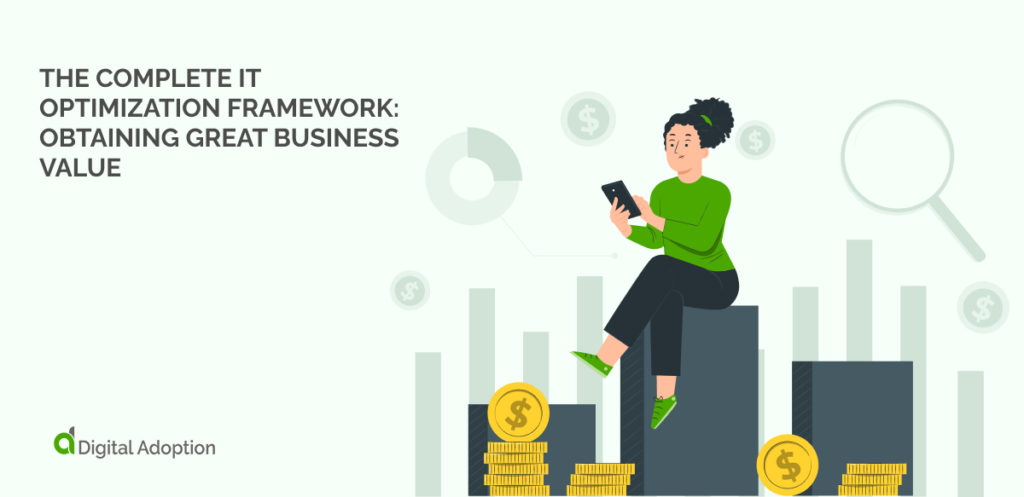
As previously mentioned, it’s too easy to mistake optimization and cost-cutting. Short-term thinking can lead to long-term problems that hinder a company’s growth. In terms of missing out on digital investment opportunities, reducing overall organizational efficiency, and stifling innovation.
Given the managerial difficulties of the process, a company may use its staff to seek continuous improvement in its IT efficiency. However, many businesses benefit from using outsourced cost optimization services, either as a one-off consultancy or on an ongoing basis.
A cost optimization framework should be practical across the company’s operating expenditure. But the scale of IT services means they have a vital role in cost savings.

